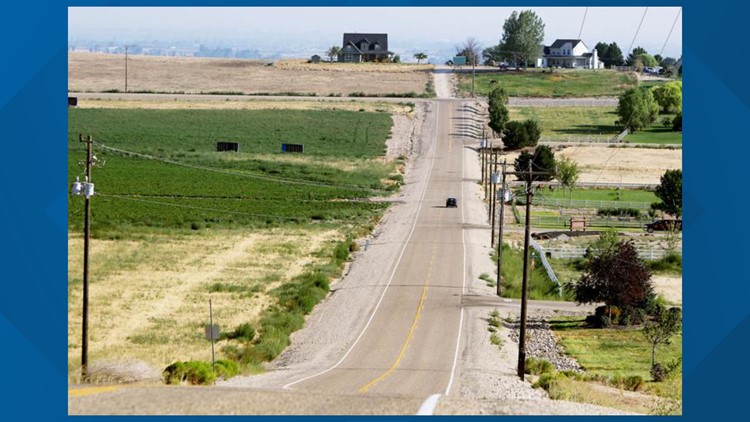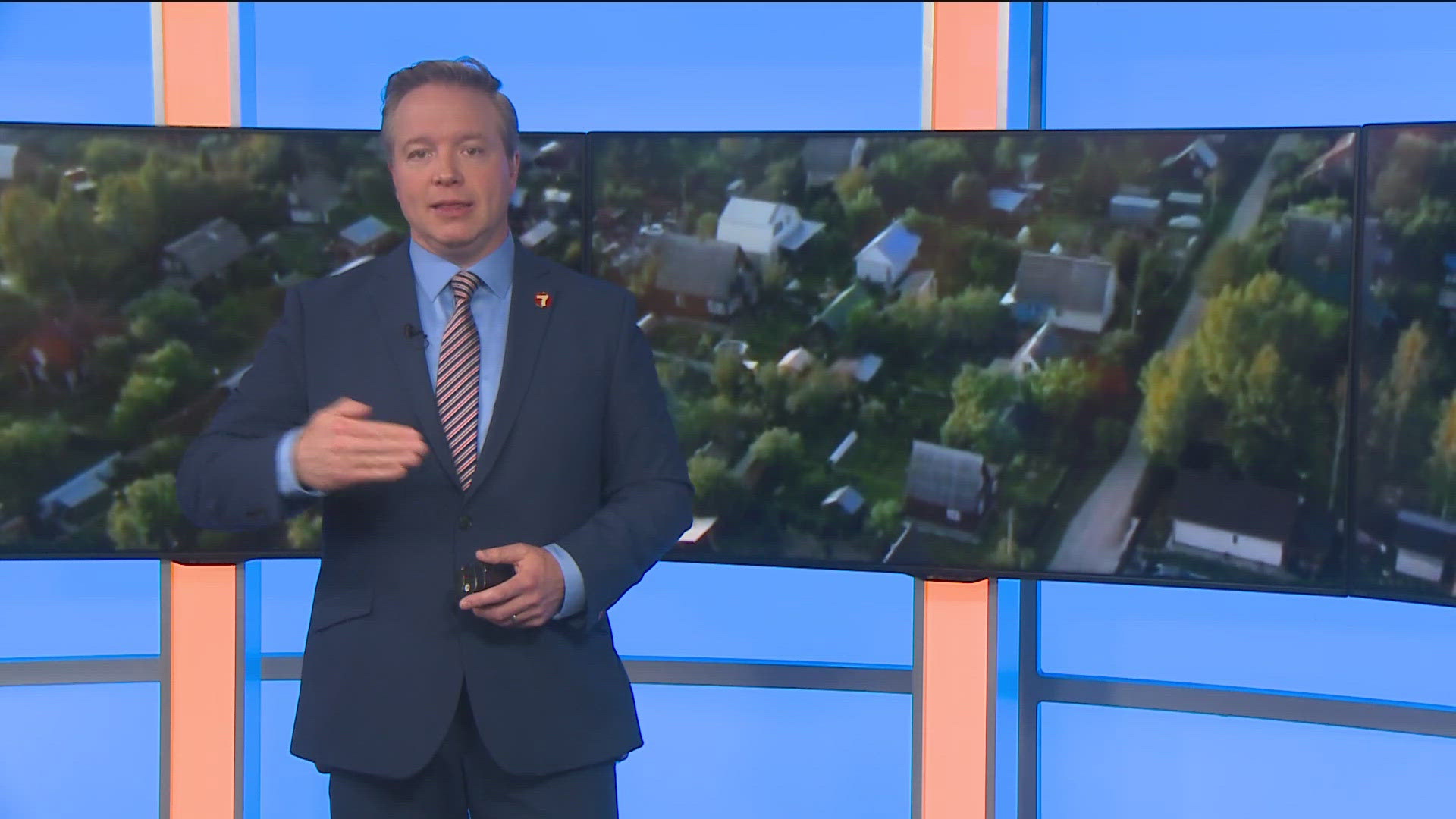CALDWELL, Idaho — Editor's Note: This article was originally published by the Idaho Press.
The debate over a proposal to build three dozen homes on 3-acres lots southwest of Nampa is a microcosm of some of the storm forces that will shape the Treasure Valley’s future — rapid population growth and a historic drought putting stress on the area’s water supply.
The Canyon County Board of Commissioners held a hearing Monday to hear testimony regarding the rezoning and installation of a new 35-home subdivision south of Lake Lowell. But neighbors are questioning the prudence of installing additional homes in an area where 10 homes’ wells went dry in July.
The proposed subdivision, designed by Taylor Jene Homes, would be developed on a 122.51-acre parcel located near the intersection of Skyview Street and Sky Ranch Road, a sloped area about one mile south of Lake Lowell. The parcel, as with the bulk of the surrounding area, is located on a large slope, and is zoned for agricultural uses. However, the area is designated as “residential” in Canyon County’s Future Land Use Map, according to the staff report written about the project for its first hearing June 28. Taylor Jene Homes is asking that the parcel be rezoned to rural-residential and to build 35 homes there, a figure which was revised down from 47 homes following testimony in the first hearing about the project on June 28.
Representatives of Taylor Jene Homes and neighbors to the area spoke at the hearing, as well as an official from the Idaho Department of Water Resources. More than 20 neighbors attended the hearing, though fewer than half spoke due to rules about limiting repetitive testimony. Speakers also were not allowed to transfer their speaking time to another person.
After nearly four hours, the commissioners moved to close public comments and continue the hearing at 3 p.m. on Monday, Aug. 2, to give themselves time to review additional information provided prior to last Monday’s hearing.
It is unknown what level of development the aquifer in that area can support.
“We’ve had concerns about the groundwater supply in this area for quite a long time,” said Nick Miller, principal engineer with the Idaho Department of Water Resources, at the hearing. That concern is why the department maintains a series of monitoring wells in that area to keep tabs on water levels, he said. However, he said that a report provided by the Idaho Department of Water Quality indicates that the groundwater supply in that area is sufficient for “current uses.”
The report analyzed data from water in the aquifer between 2005 and 2020, and concludes that the well issues that have been brought to the attention of the department are likely due to issues with well construction or ability to convey water, and due to water not readily moving through the aquifer.
That claim does not sit well with some residents of the area. Kim Yanecko, whose home is located in a subdivision across the street from the Taylor Jean Homes’ subdivision, has been working to rally neighbors to oppose additional development in the area until further studies are done to assess the status of the aquifer.
“So IDWR says we know current uses are good,” Yanecko said at the hearing Monday, “but what they aren’t saying is that we have all of these homes that could be built, haven’t been built, and could get built all at the same time, and we have no historical data to show that suck on our aquifer.”
The land south of Lake Lowell is county land, and as such, the county’s elected board of commissioners is tasked with giving final approval to rezoning and development projects there. If this subdivision were approved, those 35 homes would be in addition to the nearly 370 homes that are already slated for construction in the area, Yanecko said.
Claudia Haynes, who has lived a mile south of the proposed subdivision for 20 years, said that she has been questioning the sufficiency of water in the area for decades. Last week, Haynes’ well went dry, as did four of her neighbors’ wells, and she has been having to shower at a neighbor’s house, she said. Haynes is also a member of the Canyon County Alliance for Responsible Growth, which is also advocating for a pause on growth in the area.
Yanecko emailed Dennis Owsley, who works for the Idaho Department of Water Resources and monitors wells in the area, to ask about Haynes’ well troubles. Owsley attributed the issue to the aquifer not being very productive at the spot that the subdivision is situated, as well as the houses in Haynes’ subdivision being too close together. The lots there average less than an acre and a half, according to Zillow, which means there are more wells pumping water close together, which can amplify water drawdown in what is known as a “cone of depression.”
Regardless of what is causing the lack of water, Yanecko thinks this unreliability is unacceptable, particularly given the cost of installing, repairing, and replacing wells.
“When you spend $30,000 on a well, you’d think you’d be able to get water,” she said at the hearing Monday.
But at the hearing, proponents of the project described the positive aspects of adding new homes to the area. Though the land is historically agricultural, it is not considered prime agricultural land, and is surrounded by other subdivisions, which is why it will be an “infill” project, said Randy Haverfield, the architect for the project who is also a Nampa City Council member. And since the lots in the subdivision will average more than three acres, they will be spaced out enough to avoid overdrawing the aquifer, said Mark Hilty, the land use consulting attorney with Taylor Jene Homes.
The commissioners were not yet ready to make a decision on the subdivision, expressing a desire for more time to review the additional documents and information submitted ahead of the day’s hearing, as well as to gather more information.
“I think that’s part of the trepidation I have is there’s just a lot of conflicting testimony, and it’s within one agency,” Commissioner Leslie Van Beek said, referring to information provided by the Idaho Department of Water Resources.
Commissioner Pam White agreed.
“I know they have monitoring wells out there,” White said, “but when was the last time they went out there, really walked and talked to people?”
On Aug. 2, the hearing will continue at 3 p.m. at the public hearing room of the Canyon County Courthouse, 1115 Albany St., Caldwell. Public testimony is now closed, but members of the public still will be able to view the discussion.
Watch more 'Growing Idaho':
See the latest growth and development news in our YouTube playlist:



